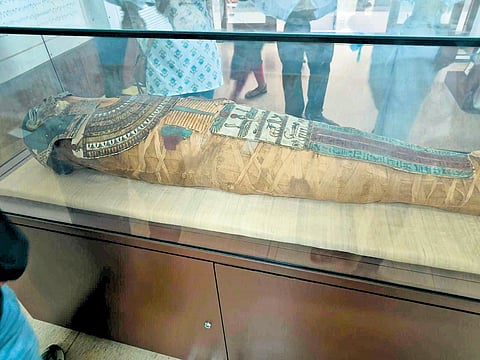

HYDERABAD: Situated within the expansive ‘Bagh-e-Aam’, an 87-year-old building serves as the state archaeology museum. Featuring Nizamesque domes and arches, the facade of the building bears a rusted iron signboard with the name ‘Dr YS Rajasekhar Reddy State Museum’ while the plaque outside displays several missing letters.
In 1937, when the last Nizam had his silver jubilee celebrations, around 20 buildings were built in Hyderabad State, one of them being the present State Central Library. A museum was built to house a vast collection of historical artefacts collected from across the state.
Besides the beautiful architecture of the building, the museum boasts a collection comprising about 93 stone sculptures and other items, dating from Satavahana to the Vijayanagara. Two ‘mandapas’ or four-pillared structures belonging to the Kakatiya and Vijayanagara eras were also brought in from Warangal and placed inside the courtyard. The mandapas, built in basalt stone but now mixed with concrete for support, display iconography similar to that in Ramappa temple. A massive wooden chariot, several veergals or hero stones, and French and Nizam-era iron cannons are all displayed out in the open, exposed to weather conditions.
The sculptures and artefact collection is spread across two floors of the heritage building. Some of the exhibits include the Gandharan sculptures, the Bidriware collection and a section dedicated to Islamic art and architecture. The most significant exhibit that could put the State Museum on the world map (had the interest of the State as well as the citizens been in its careful maintenance), is its almost 2,400-year-old Egyptian mummy.
Nazeer Nawaz Jung, a nobleman, bought the mummy for about 1000 British Pounds and gifted it to his brother-in-law Mir Osman Ali Khan in the early 20th century. The mummified body of Princess Naishu, the daughter of the sixth Pharoah of the Ptolemaic dynasty, has gone through its own adventure of being exposed to sun and air before it was finally restored and encased in an oxygen-free, glass chamber. This is one of the six Egyptian mummies in the country.
The museum also houses a vast collection of coins from various periods, not displayed due to a shortage of staff and funds for maintenance. Empty wooden cases carelessly lie in the corridors of the ground floor of the museum.